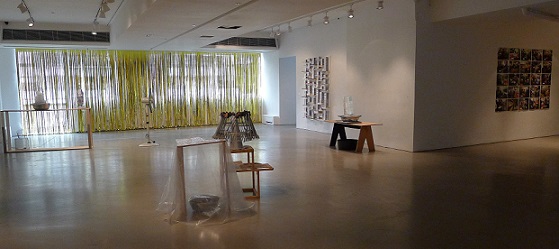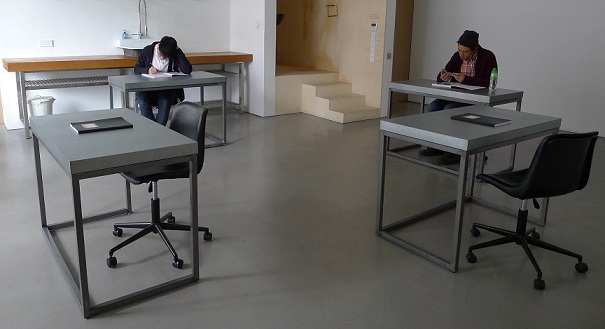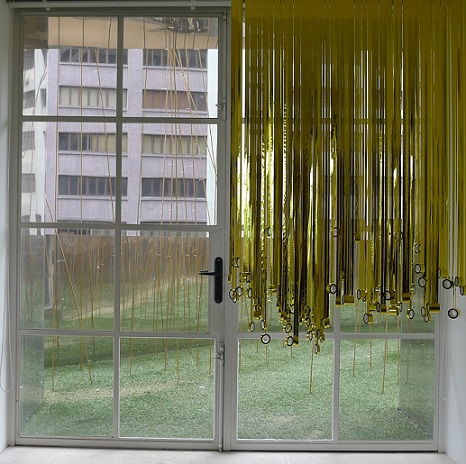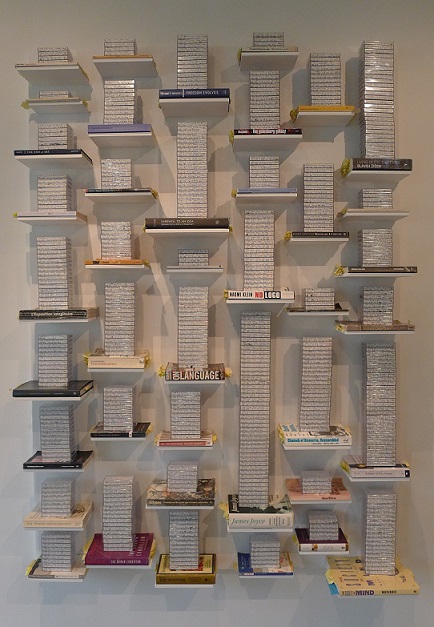Reviews & Articles
Days push off into nights - and Authority
John BATTEN
at 7:39pm on 23rd April 2015




Captions:
1. Installation view, Spring Workshop, March-April 2015.
2. Elmgreen & Dragset, Hong Kong Diaries, performance installation, 2015.
3. Magdalen Wong, Sunrise, Sunset, mixed media installation, 2015.
4. Job Koelewijn, installation view of tapes, 2015.
(原文以英文發表,題為〈日夜雙生 - 以及權力〉。)
In art, as in life, everything is connected. Over time, control and power is never far from most events. It has prompted explorations of the human psyche for millennia: Sophocles’ Antigone, Shakespeare’s Macbeth, George Orwell’s 1984, Arthur Koestler’s Darkness at Noon. Countless books have studied China’s Cultural Revolution or Germany’s Third Reich and have reflected on our propensity to be controlled and, at times, its improbable acceptance.
A consequence of power relationships is obedience and authority. Researcher Stanley Milgram, in his experiments begun in 1961, studied various controlled experimental scenarios that led to his controversial conclusions about how people behave and the levels of obedience they accept when ordered by different faces and degrees of authority. Milgram summarized these experiments:
“The legal and philosophic aspects of obedience are of enormous importance, but they say very little about how most people behave in concrete situations. I set up a simple experiment at Yale University to test how much pain an ordinary citizen would inflict on another person simply because he was ordered to by an experimental scientist. Stark authority was pitted against the subjects'' (participants'') strongest moral imperatives against hurting others, and, with the subjects'' (participants'') ears ringing with the screams of the victims, authority won more often than not. The extreme willingness of adults to go to almost any lengths on the command of an authority constitutes the chief finding of the study and the fact most urgently demanding explanation.
Philippine artist Santiago Bose depicted another aspect of authority in his 1996 video Jaguar at the Western Frontoriginally shown in Vancouver, Canada. He shows a bored/tense/alert Filipino security guard (played by Bose himself) pacing up and down, sitting, and watching a set of six unseen television monitors. This bank of monitors, however, is what the audience is actually watching, with the security guard as the main object of attention. Each monitor flickers; and the roving cameras capture and depict different angles and time sequences, while the grey-tones of the moving security guard, himself under surveillance, explore the tension of observation.
Bose is dressed as a security guard and ‘armed’ with the tools of someone in authority (in this case, a bank of observation monitors). In this work, Bose skillfully plays with cinematic implication to raise interest in his video performance. We are waiting for something to happen, because we can feel that something will happen. But, nothing does.
We are, however, watching a bored security guard. Bose is making a cultural observation – this Filipino security guard (just visit Macau to see the many guards who are Filipino) suffers from ennui: although alert, he is bored.
Likewise, the hundreds of thousands of security and surveillance cameras that have been installed around the world – especially after the attacks on New York’s World Trade Center on 11 September 2001 – actually record nothing of consequence most of the time. Nothing.
In Wong Chuk Hang, Spring Workshop’s Days push off into nights, curated by Spring’s newly appointed Programme Director Christina Li, is an excellent exhibition about “stillness”. It is a quiet exhibition at a slow pace. Too many exhibitions, as in life nowadays, are too busy, too crowded; just too noisy: they jostle - rudely jostle - for attention. This exhibition tackles that stolid theme of artists: time.
One hundred and fifty years ago, time was seemingly captured in Eadward Muybridge’s photographs of animals in motion. In 1872, with his innovative stop-motion photographs, Muybridge famously ended an argument about whether a galloping horse had all four legs off the ground at the one moment (they do). Muybridge’s work was the precursor of today’s cinema, and highly influenced later artists, especially the Futurists, and Surrealists led by Marcel Duchamp with his pivotal painting Nude Descending a Staircase, No 2. They sought to depict movement – and observe time.
Similarly in this exhibition, Magdalen Wong’s Sunrise, Sunset adheres metres of rolls of gold tape above a window. The rolls slowly succumb to gravity and unravel downwards, some unrolling slower than others, unrolling in their own time. Nearby is Dutch artist Job Koelewijn’s visual depiction of reading books. As he reads in 45-minute slots each morning, he records the sounds around him; in a sense it is the sound of him reading. The tapes are kept and stacked atop the actual books he reads. His entire installation, a neatly shelved display, has an archivist’s obsession. Time preserved for future listening, the passage of reading; moments in Koelewijn’s life.
Olga Chernysheva’s Screens of five filmed sequences in Russia are leisurely “portraits” of life: a train traveling through a beautiful snowy landscape; villagers chatting together while casually eating snacks; a man exercising. These videos are ruminations on the mundane, life without drama: how most people spend their time.
In another room, four young male teenagers are employed to write their own diaries – the most traditional noting of time - each day. If you watch this performance, the idea of Scandinavian artists Elmgreen & Dragset, these young men are often fidgety, no doubt waiting for the moment they can leave for the day. It visually notes their obedience, and possible annoyance, to the imposed control of their time.
A version of this essay was published in The Peak magazine, April 2015.
